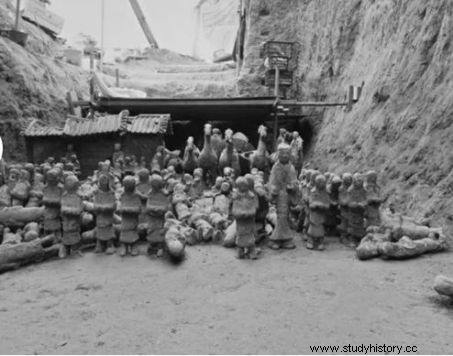2,100 years old, hundreds of clay figurines - soldiers, chariots and horses - have been unearthed in eastern China. This discovery, which dates from 2007, has just been revealed in a publication.

A 2,100-year-old burial pit containing a mini terracotta army has been unearthed in China.
Horsemen, chariots, infantrymen, musicians…a whole miniature terracotta army* was exhumed from a vast pit located in the Linzi region, in Shandong, the former capital of the State of Qi, in eastern China. Dated to around 110 BCE, this battalion of hundreds of petrified figures would have accompanied in death a high dignitary of the Han dynasty, reveals the journal Chinese Cultural Relics, relayed by the online publication Live Science . Made in 2007, this discovery was not published until 2016, once the archaeological excavations had been completed. The figurines may have been made upon the death of Liu Hong, son of Emperor Wu Di of Han (141-87 BCE).
A few black and white photos made public by Chinese archaeologists allow us to contemplate the forgotten army. The princes used to be escorted on their journey to the afterlife, not only by soldiers and servants of clay, but also by animals and various objects necessary for life in the kingdom of the dead.

Focus on one of the miniature horsemen found in the burial pit in Linzi, China. Credits:Chinese Cultural Relics.
This type of burial was reserved for monarchs, princes or very high officials. The most famous of these, which visitors from all over the world come to admire in Xi'an, Shaanxi, was fashioned to protect the tomb of the "First Emperor" Qin Shi Huang Di (259-210 BCE). It is made up of more than 7,500 life-size warriors, unlike Linzi's mini-army, whose miniatures are 21cm to 32cm high (apart from a few watchtowers reaching 140cm). The terracottas were arranged in a specific order:"The cavalry and chariots in the southern part; 300 infantry in a square formation in the center; and the musicians in a small pavilion in the north (Music played a major role in Confucian imperial rituals).

Infantry elements represented in terracotta. Credits:Chinese Cultural Relics.
According to the Chinese review, the grave attached to the pit housing the clay troupe has not been located. Old locals, however, explained that a 4m high burial mound once existed...but the train had passed by! In 1969, the construction of a railway line led to the leveling of the artificial hill, erasing the location of the tomb. The ruins of the city of Linzi being surrounded by a hundred burial mounds, other discoveries undoubtedly remain to be made, despite the desecrations and looting practiced since Antiquity.
Funeral terracotta or mingqi
Under the Han, the progress of filial piety encouraged wealthy families to bury their dead in the midst of an incredible amount of clay funerary furniture, going so far as to represent all the objects and characters of daily life. This aristocratic custom then spread to the entire population, to the point that under the Tang (618-807), it was necessary to create a monitoring office for the production of mingqi, to limit their number in the graves.
